|
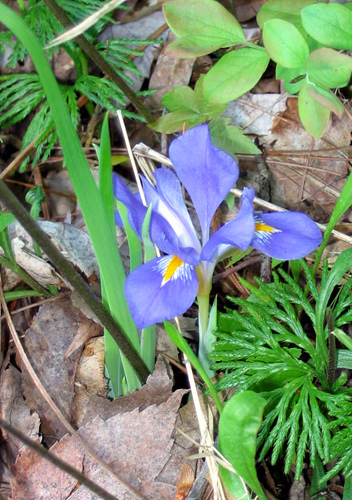
Iris verna, dwarf iris
(*photo
credit)
June 1, 2007 Healing Appalachia
The book, Healing Appalachia: Sustainable Living though
Appropriate Technology
(with Paul Gallimore as co-author), has just
been published by the University Press of Kentucky. Some readers
have asked for a synopsis. That is a very difficult task to do
within the five hundred word limits of these daily reflections,
since it is nearly five hundred pages, and each of the thirty
entries on areas of appropriate technology (e.g., passive solar
energy, compost toilets, edible landscaping) is only treated in a
summary fashion. However most of these thirty subject areas have
been mentioned in one or more of the previous daily reflections.
Within this book, we have tried to develop a more systematic
approach that treats these subjects in a logical order while cross-
referencing the different sections. We have also included several
hundred pertinent references that can afford a reader an in-depth
understanding of the specific area.
Criteria for choosing the thirty entries from the wider field
of appropriate technologies are given in the introduction. These
are all methods that have proven to be ecologically sound, people
friendly, and community enhancing besides being obtainable for
moderate to low cost at the domestic or community level. Other
possible entries have been excluded because they are not specific
to the region being considered (e.g., straw-baled housing), or to
the American cultural situation (e.g., domestic methane
generation). Other techniques could work for a very few but are
not of general practical application for all in a community (e.g.,
biodiesel from local waste cooking oil). With the exception of
windpower, all techniques have been tried by either Paul Gallimore
or myself in the centers we have directed over the past three
decades. Note that Paul has an excellent wind location near
Leicester in the 1,600-acre Long Branch property but that wind
turbines have not yet been installed due to clearances.
Healing Appalachia offers a practical hope coming from a
region that has given much raw material (coal, timber, etc.) and
some of its best sons and daughters in out-migration; maybe, just
maybe, the suggestions in this book will inspire people both within
and outside of the region to apply these ideas in their homesteads
and in their communities. If this is done -- renewable energy
sources will replace coal-powered plants; water quality will
improve; disposal of domestic wastes will be handled through
compost toilets; food costs will decline and more nutritious food
would be available; buildings can be constructed using local
building materials and employees; heating and cooling costs will
decline; and the wildlife will be protected and allowed to thrive
again. In every respect, the quality of life in this region could
improve. But there is more. These thirty subject areas are
general enough so that they apply to other places in our fair land
and even in other parts of the world. We truly believe that
Appalachia has much to offer others that can fit under the aegis of
appropriate technology. Instructions on purchase of the book are
given else on this website.
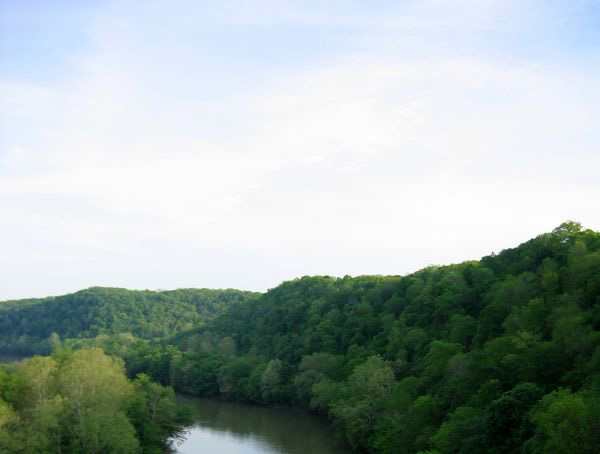
Kentucky River scene
(*photo credit)
June 2, 2007 Ten Reasons for Celebrating Rivers
On this annual River Day it may be interesting to list all the
reasons we have for celebrating rivers:
1. Beauty -- Rivers for the most part have a natural beauty in
the running water, the way it flows, the meandering of the stream,
and the trees, banks and cliffs that border rivers.
2. Bounty -- Rivers offer sources of fish, mussels and other
marine life that may not be available otherwise. River shorelines
include marshes and vegetative varieties not found elsewhere.
3. Fragility -- We can celebrate what can easily be spoiled
but that has instead been protected or restored through human
efforts. So often rivers can be damaged and the heart of
celebration is that what has been harmed can be repaired through
considerable effort -- a cause of celebration.
4. Harmony -- Rivers enhance an otherwise monotonous landscape
and give the necessary ingredient in land/water relationships.
Rivers are able to give a pleasant sound through rapid current or
waterfalls.
5. Peace and tranquility -- Rivers need not be productive or
even plunged into in order to be a source of enjoyment. In India
and elsewhere rivers can even take on a sacred character.
6. Recreation -- Rivers are great places to paddle, row or
operate a motor boat, to wade, swim or soak, to fish or accompany
others who like such activities, to float and gaze to the heavens
over water, or to dangle one's feet in the moving waters. Rivers
are often land-locked people's only access to much water.
7. Respect -- Although fragile, rivers can be mighty and can
flood and cause devastation in quite unexpected ways and over
extremely short time spans. Drownings occur in rivers and so the
life-giving water can bring death suddenly. Respect and awe go
hand-in-hand in our treatment of wonder-filled rivers.
8. Transportation -- For centuries people and goods moved more
easily on rivers than on land. While travel modes have improved in
the past hundred years, still bulk coal and other materials are
moved more economically through river barges.
9. Water source -- Rivers are the vital water sources for many
uses from domestic uses and bathing to hydropower and irrigation.
Nations quarrel over water rights, and efforts must be made to
divide the use of water throughout the river basin equitably.
10. Worth -- Rivers offer so much for all that they attract
residents whose riverside properties are more highly valued because
of scenic views and other advantages.

Backyard habitat: Unidentified mushrooms
(*photo
credit)
June 3, 2007 Wisdom and the Trinity
From everlasting I was firmly set, from the beginning, before
Earth came into being. (Proverbs 8:23)
Certainly the eternal Creator has design in God's timeless
existence and this is a delight as made known in the Proverbs that
we read on this Feast of the Holy Trinity. Each year we attempt to
find some aspect of this fruitful and yet never totally plumbed
Mystery (see 6/5/04; 5/22/05; and 6/11/06). Here we touch on the
wisdom of God that has always existed and is so deep, and so
penetrating that the person of Jesus Christ is begotten not made.
Francis S. Collins, the American scientist who was the team
leader of the Human Genome Project, stands at the cutting edge of
modern scientific discovery with his DNA work. During the course
of his life, Francis Collins has moved from a world of agnosticism
to one of Christian belief; he gives testimony to this in his very
clear and well developed book: The Language of God: A Scientist
Presents Evidence for Faith (New York: Free Press, 2006). This
book is a must for all who seek to dialog with a materialistic
world that is becoming more vocal in its agnosticism and antagonism
to religious belief.
Collins does not tackle the deep mystery of the Trinity (the
word is not indexed in his book). However, one perceives
throughout his writing that the wisdom of God lies behind the
marvelous display of evolution and its manifestation in the
emergence of all living things. That wisdom is expressed through
humble and intelligent seekers of truth like Collins and others.
It is a vast and yet hardly tapped wisdom that is a delight by the
All Wise; it can become the delight of us all when discovered ever
so slightly in our own journey of faith. Where the Trinity
implicitly enters into this book is that the personal presence of
God in the lives of Collins and other believers is the Person of
Jesus Christ who is the Wisdom of God. Wisdom is a Person and in
the private lives of believers this point of meeting is where the
Trinity enters their lives in a most personal manner -- a point of
acceptance that then becomes the starting point of carrying the
message to the rest of the world.
Through the fullness of Baptism we are other christs and we
delight the mind of God in our being born, living, and passing from
this mortal life -- and yet we too are always in the mind of the
Creator. One immense and cosmic difference is that we are born and
not begotten; another is that we do not give perfect delight
because we are imperfect and sometimes fail to make the mark; and
a third is that our own awareness springs forth as we journey
though life with no antecedent or other consciousness on our part.
And thus we grow as did the boy Jesus in wisdom and understanding.
But we are called to become more godly through baptism and through
the acceptance of and working with the gifts given to us throughout
our life. Wisdom gradually becomes part of us -- and this can be
when seen as gift and delight to God and us.
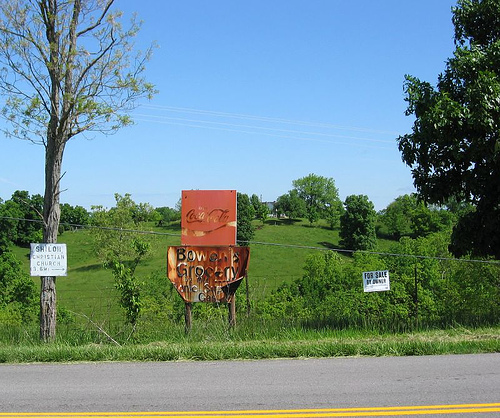
Rural roadside farm scene, Anderson Co., KY
(*photo
credit)
June 4, 2007 Wisdom: Recognizing God's Gifts
Each month during the rest of this year we will reflect on one
of the seven gifts of the Holy Spirit. The first of the gifts
mentioned in Scripture is that of wisdom, and this gift is quite
fundamental for it involves recognizing the presence of gifts.
When we exercise our gift of wisdom, we become more godly in a
Trinitarian manner (see yesterday's reflection). God's wisdom is
expressed in the works of creation and these are gradually revealed
through scientific discovery. Our wisdom is accepting these works
of wisdom and blessing the God who allows us to help reveal them as
Good News and gifts for all. Being wise is more than a private
relationship between God and me; it involves a communal dimension,
wherein wisdom is shared with others through my own actions and
that of working together with them on cooperative endeavors.
Thus wisdom becomes an ever expanding and ultimately a global
enterprise -- a working together to build the Kingdom of God.
Sometimes a different interpretation is rendered; for some,
the gift of wisdom means that we are to be detached from this world
and relish and love only the things of heaven. One can quote St.
Paul who says that "our citizenship is in Heaven" (Phil. 3:20).
However, wisdom has a somewhat broader interpretation, for in the
Psalms we read, "Teach me to count how few days we have and so
gain wisdom of heart." (Psalm 90:12)
Knowing our limitations in the current situation (mortality,
limits on resources, and restricted circumstances) is part of
wisdom, but this recognition is coupled with the willingness to see
opportunities for acting in a most positive manner even amid
limitations. The specifics of those opportunities are found under
the succeeding gifts, but the overall viewpoint needs to be present
and operative. Thus there is present a simultaneity between what
is possible, and what we are willing to do working within barriers
and limitations. Perhaps in the course of the activity in which we
are engaged we crave a day when such limitations no longer exist --
and that means the "things of heaven," but right now we are called
to do with what we have and "to make hay while the sun shines."
Recognizing the possibility of focusing on actions and being
willing to move forward is an atmosphere generated by wisdom.
Many regard wisdom to be showing how self-sufficient we are
and how skilled we are at handling a current situation without
exterior assistance. However, such an approach can actually be
quite unwise for it fails to see the situation properly, and it
ignores other resources that may be available to assist in
completing the tasks at hand. This failure at seeing and being
able to deal with one's own limitations (whether personal or
communal) is our common weakness. Being at peace with limitations
allows us the opportunity to look out to others and ultimately to
the Holy Other. Obviously, this is the first of the gifts, for
unless we come to terms with barriers we cannot move forward to the
goals we seek to achieve our journey of faith. If we are wise, we
can travel more comfortably.
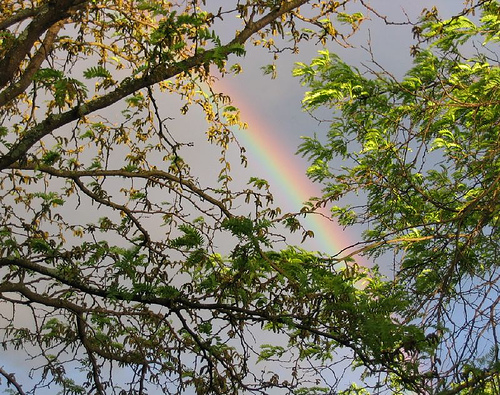
After the rains
(*photo
credit)
June 5, 2007 Backyard Gardening versus CSAs
Often it is wise to avoid certain subjects for these can
inadvertently get the writer and speaker into trouble. A question
from an audience in Columbus, Ohio, about a decade ago deals with
the subject of my strong advocacy of backyard gardening; this
seems at odds with those noble souls who are gaining a living
through Community Supported Agriculture (pay ahead in the spring
for guaranteed delivery of produce during the growing season). See
6/6/06 for details of this method of livelihood.
I am certainly not against CSAs and think these practices are
a far better approach to obtaining one's produce than supporting
corporation-produced food from thousands of miles away -- and often
grown with abundant commercial fertilizers and pesticides. What I
conceived of in the height of my own backyard gardening experience
was that much could be said about gardening on one's own and the
more said the less time should be given alternative (non-self-
gardening) practices. It was all a matter of who did the growing
and not what methods (organic, mulching, raised bed, etc.) were
employed. I have always been supportive of farmers' marketing
people who specialize and are able to furnish some bulk crops that
backyard growers are unable to supply to their own households.
Older age and a weakening back have mellowed my advocacy
fervor for total backyard garden production by everyone. There
come times in human life when others are to help weaker members of
the community. Homesteading demands able and willing workers and
all of us outlive the middle age agility and strength necessary for
large-scale or even moderate-scale gardening. I had an Uncle Louis
who was a gardener all his life, and he dropped from a full-scale
(with hired help) to a moderate-scale gardening in his eighties and
early nineties. Even he, like all of us, needed to cut back -- and
here is where the CSAs have a legitimate niche in the food
producing scene. When we look more tolerantly we find a host of
people who cannot garden: infants, elderly, some of the disabled,
but also many who are almost totally engaged in other activities.
But I hesitate with the last group, for all people need exercise,
sunshine, and fresh air for sustaining good health -- and backyard
gardening is an answer. Even the excuse that one does not have a
backyard is not totally satisfying, but that excuse is often true.
Truly each of us can only grow so much food with our limited
energy or physical resources and thus there is an opening for CSAs.
I have also faulted a mentality that believes we need to pay others
to do what we should be doing ourselves, namely growing some of our
own food. The arguments of disability do not fully suffice for
some like Pat Brunner of Berea, Kentucky, maintain gardens from
wheelchairs. The arguments of busyness also do not suffice, for
all need healthy exercise; the arguments for old age should not
discourage at least some potted plants with herbs. But taking all
these folks into consideration, CSAs are fine opportunities for
restricted gardeners, but not for those with the time, resources
and energy and yet a fear of soiling their own hands.
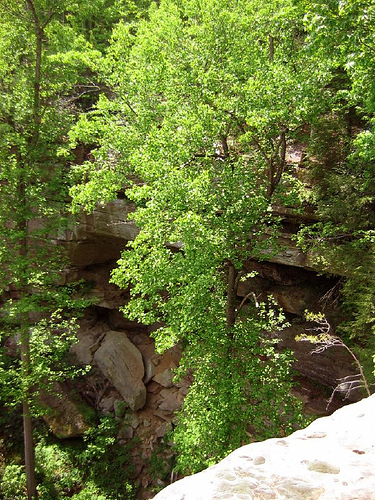
Along the Sheltowee Trace
(*photo
credit)
June 6, 2007 Sheltowee Trace
The older "traces" of mid-America and beyond were often
remnants of the ancient Native American trail systems, which were
highly used. Many of these earlier inhabitants were well traveled.
One of these trails is the approximately 268-mile Sheltowee Trace
that is managed by and on the lands of the Daniel Boone National
Forest (a ribbon of land going in a southwesterly direction from
northeastern Kentucky to Tennessee). The trail actually goes from
northern Rowan County in northeastern Kentucky to Pickett State
Park in northern Tennessee. The trail touches such scenic sites as
Cave Lake State Park, the Red River Gorge, Natural Bridge State
Park, Cumberland Falls State Park, and the Big South Fork National
River and Recreation Area. Just the listing of these natural
treasures means that the trail is a perfect one for hiking. Two
photos this month give a glimpse of that beauty.
The Sheltowee Trace is quite rugged but is being improved over
time with better markings. Portions are on rural roadways; some
are open to more than hikers, and thus in places horses, mountain
bikes and even off-road vehicles of certain types are allowed. The
connecting with five or more park-type areas allows for the hiker
to refurbish food supplies and other necessities after about one
hard day's travel -- a type of amenity that many of us moderate
hikers appreciate.
Why the strange trail name? "Sheltowee" means big turtle, a
name that was given to Daniel Boone when he was adopted as a son by
the chief of the Shawnee nation, Blackfish. Actually, the big
turtle is also used as a symbol by various mid-American tribes as
a name for the continental land mass (North America) on which they
dwell. In an ironic way, once several of us hikers on the
Sheltowee Trace came across a squashed tarpon, the victim of an
off-road vehicle using, or better misusing, this trail.
Unfortunately we did not document this with a photograph but it
tells a story of how the Trace is being threatened by those who do
not treat the flora and fauna of the territory with deep respect.
It is amazing what varied sites the Sheltowee Trace includes:
mountains and low hills, woodlands and grasslands, coves and caves,
rock formations (natural bridges and cliffs) and waterfalls, and a
wide variety of flowers and mammals. Kentucky was always known for
its abundance of all forms of wildlife, and in the course of hiking
this trail many will be observed. One would be well advised to
keep a journal or picture collection of the variety of sights.
This early part of June, which includes National Trails Day,
is a perfect time to consider hiking a portion some scenic trails
this year. There are many more than just the Sheltowee that are
opening and being marked for outdoor recreational use. Hiking is
a better way to go if you have the energy and time to do so. For
further information see <www.sheltoweetrace.com>.
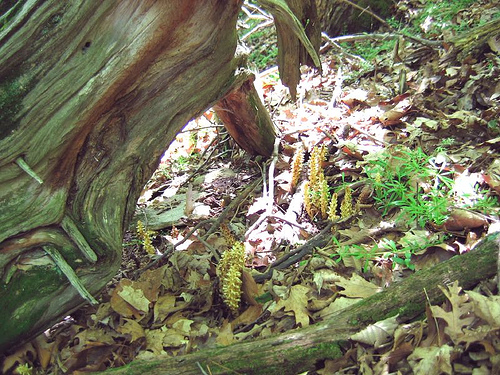
Squaw root, Conopholis americana
(*photo
credit)
June 7, 2007 Lazarus' People
Dimming eyes may be a blessing in disguise,
for we fail to see what a well-tuned ear can hear,
the cracking whips, rattling chains, squeaking shackles
of yesteryear.
Surely, surely they have not returned to haunt us,
for we are prone to make-believe, half-baked lies.
Is allowing destitution condoning slavery too?
Is Dives' doorstep our Internet? Our tv glue?
Are pharisaic calls for liberty hollow indeed,
a greatness trapped in democratic ways, where greed
sequesters much and hides rags, forgetting terror reigns
and even cajoles, holding out empty rice bowls.
The propertied cling to divine right of kings,
and belittle rightful taxes for the wealthy few:
"Let them play the lottery and become rich too;"
Let's forget to Whom all wealth truly belongs;
Let's cheapen the "commons" until it is dethroned;
Let's wring out joy and goad the crowd to sing.
-- Another wide-eyed, hopeless, and hungry wantabe,
"Let's take what is rightly ours by violence or otherwise;
"Let's bless the suicidal vest, shoot in the air,
and dare chide Wall Street and the billionaire;
Let all come to see, the treasures are for us all,
the world's poor are our own -- a part of WE.
-- O God of mercy, turn scarlet to white, false hearts true,
the silent to speaking, contented to uneasiness,
and help us, the deaf and blind, for we surely need
listen to Jeremiah's words and see Moses' deed,
for we fail to hear and see and heed.
Our prayerful words need be few -- help us renew!

Rosenbaum Usonian House: Frank Lloyd Wright.
Florence, AL
(*photo
credit)
June 8, 2007 Architects as Earthhealers
On the birthday of Frank Lloyd Wright we are drawn to the
notable successes of this noted architect. How could we fail to
admit that architecture has a role to play in healing our wounded
Earth? Thank heavens that architects are awakening to this vital
role. We have regarded highly architects who have shown an
interest in helping us in our resource assessments, for they fill
a gap lacking in our limited experience. Nevertheless, we may have
differences as to the size of structures to be refurbished or to be
planned and built. We believe in reuse of buildings and building
the smallest structure that can perform a given task. But new and
larger buildings mean higher construction costs and architect fees.
Even though in principle we all agree in utilizing conservation
measures, we may clash with architects over that size issue that
is critical in "greenness" of buildings (see April 5, 05).
Architects are necessary; they strive to build aesthetically
pleasing structures on particular land; they visualize the future
building's color, shape and blending with surrounding structures
and terrain. And they can do so in ways that we the untrained
would never even conceive -- and that is why there have been
notable architects such as F.L. Wright. That necessity is all the
more critical today in the age of climate change and global
warming, because during a building's lifetime large amounts of
fossil fuels will be required for building materials and, for non-
solar buildings, heating and cooling.
This is also Best Friends Day, and so we realize the value of
keeping friendships with architects. We need to work with them in
so many ways and encourage them to meet the needs of the present
age. But architects have their own hopes and ideas and yet are
constrained by the wishes of the people who are paying the cost of
the construction. Of all artists, the architects are one of the
groups most at the mercy of the ones paying the bills. A painter
will create his or her work of art at relatively low cost even if
not accepted by the art loving community at that time. Head-strong
artists risk starvation. But the architect's real artistic delight
is not plans and designs but actual buildings that cost more than
paint, brush, and canvas. Architects are more at the mercy of the
sponsor or patron.
Many of us would love to have the combined scientific and
artistic skills required for creating good architecture. But that
is limited to only a few in our society. These very few, in turn,
must have the political skill to convince the client of the need
for certain innovations and conservation measures and to still be
able to satisfy the engineering demands of regulators and safety
agencies. And then there is the balancing act of the governmental
zoning regulations. To add to this what do architects say about
ecological advocates for fewer and smaller buildings? Here public
and private interests may tend to clash -- and we hope the
architect community responds well to the immense challenges of our
times. More power to the truly green ones!

Marietta, age 93. Wise Kentucky
woman and beloved mother, grandmother,
and great-grandmother.
June 9, 2007 The Treasure of Seniors
It has occurred to me on this Senior Citizens' Day that had
the wisdom of our elders been heard and respected we would not have
had this current Iraqi entanglement. But the current American
tradition is not to respect the opinions of elders, the ones who
have experienced wars in the past; and so through disrespect we are
forced to repeat the blunders of history.
Our culture never questions some of its wrongheaded
assumptions. One of these involves the place of elders in the
society in which we live. Elders are more numerous now than they
were in the past, for people live longer. In the past several
generations shared the same household domestic and farm tasks to a
great degree, and the elder's place was never questioned. But in
the hustle and bustle of modern life the elder sometimes,
especially when requiring more care, is thought to get in the way.
In this consumer culture, the health needs of the elderly are seen
as a burden and the presence of these people as a hindrance to
modern mobility.
An overly pampered younger generation can become thankless and
stiff-necked. While religion calls for being humble and bowed
before the Almighty, a lack of religious respect extends to a lack
of respect for elders. When we lack the graciousness to pause and
give thanks for the benefits received, we lack a sense of
appreciation -- and that includes the things given by the preceding
generations. Those lacking a sense of history regard the elders as
so much flotsam and jetsam (that which is thrown overboard to
lighten the cargo on a distressed ship). Nothing like this is
officially said, but it is the unspoken position of a culture that
encourages those who are limited in their abilities to pass quickly
from the scene, to terminate life, or to join retirement places.
Seniors are treasures in a number of ways: their presence
reminds us of all who sacrificed for us through the years and who
make us who we are; these have experience and wisdom if we only
ask them for assistance; their sufferings when offered with the
love of God at heart have immense value in this world starved for
lack of gratitude. This last mentioned is the final and greatest
act of the senior -- the departure from this life in a certain
quality and style. Even when under total care, their cooperation
is essential and their smile is an education for us all.
We may have many chances to encourage today's senior relatives
and friends; we need to testify that their final years can be
quality-filled ones. Beyond receiving basic essentials in food and
housing, they need to see that their time spent is of immense value
to the healing of this Earth. When they offer their sufferings and
loneliness with Christ on Calvary they are helping fill up what is
wanting in those sufferings. They are extending the redemptive act
to others who can see and do the same in their own lives. The
senior who is joyful and thankful is one of the greatest
evangelistic treasures that we have today. May we value these
senior treasures!
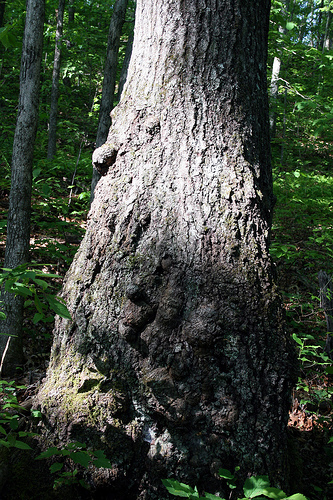
Scaret oak, Quercus coccinea
(*photo
credit)
June 10, 2007 Corpus Christi and Public Devotion
Until the Lord comes, therefore, every time you eat this bread
and drink this cup, you are proclaiming his death. (I Cor. 11:26)
In parts of the Catholic world this day involves processions
and outward festivities; they have been historically motivated by
the desire to profess the truths contained in the Corpus Christi
(the presence of Christ in the Eucharist). This tradition has
never been prominent in the United States except in rural and urban
Catholic ghettos. Religiously committed Americans are reluctant to
confront material secularism through public acts of piety and
devotion. But a public display of faith has deeper meaning. In
participating in a religious Corpus Christi procession the faithful
are more than bystanders. They testify to their faith both to
their families and to anyone who might incidentally observe. They
know religion is public by its very nature.
How can we publicly manifest the death and resurrection of
Jesus in an increasingly secular world? Some opt to pray privately
in their homes or at liturgical services among fellow believers --
and thus the travelling forth and gathering is a public action.
But should we do more through public proclamation than attend
worship on a regular or irregular basis? We see believers in other
lands who are called to suffer because of their beliefs -- such as
now endured in repressive regimes in Burma or Saudi Arabia and in
more subtle ways in Vietnam or China. Profession in such lands
exposes repressiveness, and that is part of Christian witness
called for in such times and places.
Public display of devotion to the death and resurrection of
the Lord is shown also in the public display of our crucifix --
Christ's suffering on Calvary that continues in space and time. In
some countries, the crucifix is the symbol of others joining with
Jesus in his eternal act that transcends space and time. Those who
generously accept God's will in their own lives, enter into the
obedience of Jesus' redemptive act through strength and courage.
We learn from them compassion and to celebrate their oneness even
while they themselves suffer or join with others who do.
Another form of devotion is to reverently sign ourselves with
the cross (finger tips touching head, left and right shoulder and
heart). This public display shows others that we regard food as
God's gift. When former Russian President Yeltsin was lying at
state at the Moscow Cathedral he helped rebuild, many who came to
pay respects crossed themselves in public as a sign of their
prayerfulness (vestiges of Holy Russia). The world was impressed.
A third display of piety that is so needed today is the
defense of our beliefs that come under attack from quite often
unexpected sources, such as otherwise religiously committed
believers. If their attack is valid but negative or one-sided, a
response is due and it needs to be public. This is a more
difficult witnessing than to join a Corpus Christi procession.
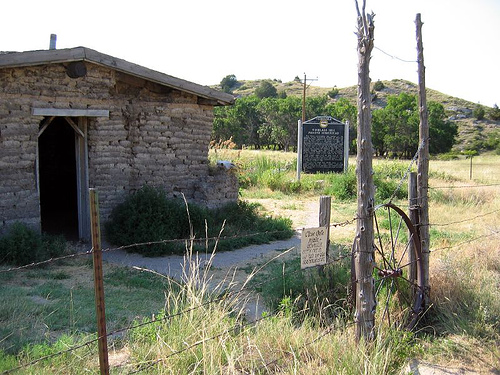
Windlas Hill, sod house - pioneer
homestead in Nebraska
(*photo
credit)
June 11, 2007 Sod and Pressed Earth Houses
As the hot summer approaches, we often wonder whether the
earthen substrate beneath our feet would not furnish the coolness
of the cave or underground home without the use of an energy-
consuming air conditioner. But who wants to live in caves,
cellars, or underground homes especially during the beauty of late
spring and summer when we like to commune with nature?
Earth is a good insulating agent and holds at a near
consistent temperature through the seasons. Those who dwell in
adobe homes in the desert west will testify to this though they add
that the sides need to be quite thick for best affects, so keeping
the living space above ground is a must for many people. The adobe
gives us a clue. We can concentrate on the insulating qualities of
an earthen wall and still have some naturally cool places (cordwood
can give the same effect depending on the thickness of the walls).
An entire section with almost all that can said about pressed earth
buildings is presented in Chapter Twenty-one of Healing Appalachia:
Sustainable Living through Appropriate Technology (see May first),
along with other types of structures such as the English "cob"
house. However, nothing is mentioned about earthen design in other
regions of the country such as the adobe buildings of the Southwest
and the sod structures of the Great Plains. Some modern pressed or
formed walled buildings require considerable amounts of costly
commercial cementing materials.
In all earth-type cases, several basic factors and principles
need to be mentioned. Materials must come from near at hand, since
they are bulky and require heavy expense for transportation if
coming from a distance. Expect that building walls with earth
could require considerable additional labor and time over what a
traditional wooden stick house or a pre-fab house of any material
will require. Direct moisture should not strike walls for this
could erode or damage them and thus the need for extended
protective roofing and wall outer coatings. Remember that only a
fraction of the total cost of a house will be in the wall that is
defining the type of house (when all is counted up, to three-
quarters of the cost could come from preparation of site,
foundations, roofing, utilities, interior furnishing and
embellishments and decorations. The walls will retain coolness in
summer and warmth in winter, if the roof and doors and windows are
airtight as well and all portions insulated by standard procedures.
Sod and some earthen houses are not necessarily beautiful and
many would find their appearance somewhat ugly. One needs to see
that pressed earth and many of these earthen walled residences can
be painted and embellished with color at different places, thus
giving a more homey appearance for the aesthetically concerned.
Actually the sod house was like the homesteader's log cabins --
temporary housing until more settled and prosperous times would
allow a larger and more elaborate building. But these structures
did have advantages as listed -- and they can prove to be an
ecological form of housing in this needy world.
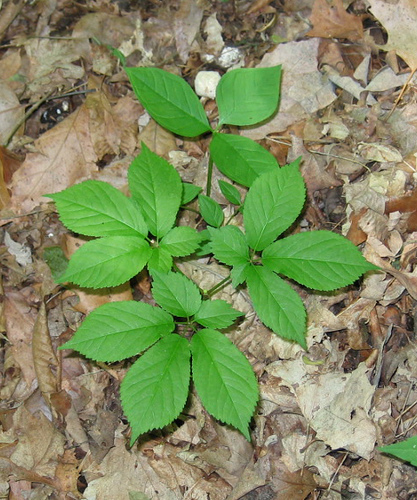
Ginseng, Panax quinquefolium,
Vernon Douglas State Nature Preserve.
(*photo
credit)
June 12, 2007 Saving Natural Ginseng
Every year we discuss American ginseng (10/13/04; 3/8/05;
4/4/06). No doubt, ginseng is a wonderful resource especially in
the wild, a potentially important agricultural substitute for
tobacco, and a prized commodity highly sought on the world market,
especially by the emerging middle class Chinese who have a long
tradition of the medical uses of ginseng. However, our wild
ginseng sources in America's woodlands suffer from a variety of
threats beyond the actual disappearance of some of these forests
due to development. Major threats come from poaching by the
unscrupulous who only see the $400 a pound price tag; they also
come from the voracious eating habits of expanding flocks of wild
turkeys that can grind the seeds efficiently in their digestive
systems and that destroy seeds (as opposed to emitting the seeds
whole as many other birds do). Poachers know that lands cannot be
completely guarded and "wild" turkeys (with some domestic genes)
are protected game birds.
Having restated these threats, we are left with the problem of
how to preserve existing stocks of native ginseng. Over time we
have made a number of proposals some of which are regulations that
must be enacted by the state or federal government, or are on the
books and must be enforced by reluctant local officials. At the
regulatory level we suggested a system similar to the tobacco
cooperative programs -- this would give marketing cards to growers
and thus proof of the property on which the ginseng has been
harvested. However, since that was first proposed a decade ago the
tobacco program has collapsed through a federal buy-out; thus this
is not an existing but a historic model that requires massive
cooperation. And adding to difficulties is that ginseng harvesters
prefer to keep places and practices secret. Further enforcement of
anti-poaching regulations is difficult since the police are already
overworked because of problems with marijuana and other drugs. In
fact, one friend last year reported to his county authorities a
theft of $4,500 worth of ginseng, and the officer did not even
record the theft as a report much less do anything about it.
Due to lack of incentives for new regulations or protection
through existing ones, let's propose a new but really not novel
approach. Let's support the proposal by Dr. Murphy at Southern
Illinois University (a ginseng expert) who is calling for the
synthesis of the major components of ginseng to make artificial
substitutes for the naturally grown ginseng -- though the
replacement will not be perfect. However, some of the medicinal
demand for ginseng could be met, just as natural rubber has been
replaced with synthetic rubber and synthesized medicines (aspirin,
etc.) have replaced natural biological materials. Wild ginseng
(Panax quinquefolium) is virtually impossible to duplicate exact
composition. However, the main active ingredients are able to be
made by organic chemists (I once synthesized organic chemicals) and
the pressure on the natural products could be reduced by lower
priced artificial materials. From a standpoint of preservation of
native species this may prove to be the best conservation route.
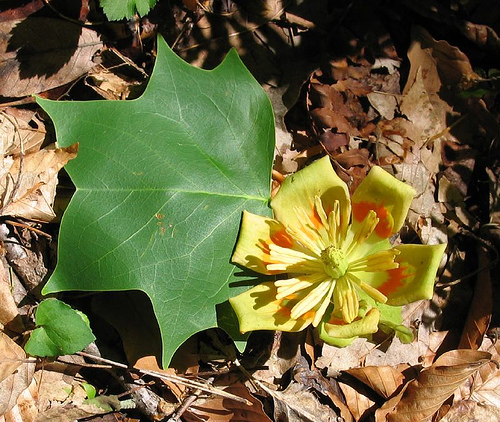
Tulip poplar flower and leaf, Liriodendron tulipifera
(the official state tree of Kentucky).
(*photo
credit)
June 13, 2007 Tulip Poplars
We tree lovers have favorites and I must confess that one of
mine is the Liriodendron tulipifera or the "tulip tree," the
commonly known "poplar," or better, the "tulip poplar." The
tulip tree shares with the Kentucky coffee tree the designation of
official Kentucky state tree, and it has many good qualities:
Tulip poplars grow fast. The tree is a rapid grower in our
part of the country and prefers deep fertile soil. It is naturally
found in coves and in well-drained areas. The older trees can
attain immense girth and some, especially in the Great Smoky
Mountains National Park, attain a twenty-four to thirty foot
circumference.
Tulip poplars are tall, well shaped and have dense foliage.
In Appalachia they can grow to heights of 165 feet and tower over
the oaks and maples. Some would object that they are not part of
our edible landscape (fruit and nut tree varieties), but the flower
(see photo) is a tulip-shaped, cucumber-scented beauty that
attracts the honey bees, which can convert nectar into some of the
most prized honey of this region. And that is certainly edible.
Tulip poplar wood is fine grained. This is a favorite for
construction and crafting. My dad, a wood carver in his retirement
years, liked to work with tulip poplar because of its beautiful
yellow and purple streaks as well as its softness. Also the wood
stains easily to various desired shades and hues. Furthermore, the
wood does not split or "check" as so many other types do. Yes
poplar shrinks and so has to be dried properly when used for siding
on a house. It preserves very well, and in some of the older log
cabins of our Commonwealth one can find fairly well preserved logs
made from the large tulip poplar trees two centuries ago. Native
Americans used the logs of this tree for making canoes, and thus
the added name "canoe tree."
Tulip poplars are less disease-prone than many other species.
Knock on wood! So many of our trees in the forest suffer from
diseases either present or arriving from other parts of the country
or distant lands; these species are so stressed that they are
prone to the attacks of opportunistic pests. We hope that no new
disease will devastate the tulip poplar. These trees are also not
subject to wind damage as are many other fast-growing varieties.
Tulip poplars are beautiful in summer. This last
characteristic is of course in the mind of the beholder. But tree
lovers must admit that this is a very symmetrically shaped tree; it
grows tall and graceful; it has even, full foliage that stays for
much of the growing season and it blends well in most forests.
But no tree is perfect. The tulip popular is great for spring
and summer but does not have the fall leaf colors of the maple,
some oaks and the sour gum. But it is a winner!
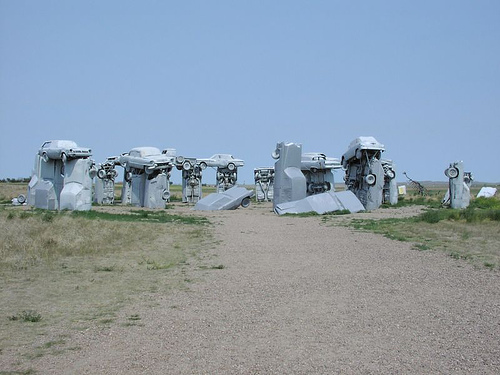
Carhenge at Alliance, Nebraska. A large replica of
Stonehenge made entirely of old cars by artist Jim Reinders.
(*photo
credit)
June 14, 2007 Old Car Art
One of the least artistic sites in Kentucky and in many other
rural and some urban areas is a collection of rusty junk vehicles
crowded around a house or work shed. What generally brings on
these collections is the desire of a mechanically minded person of
limited means to tear out working parts of these worn out and
wrecked vehicles that have seen better days. The collections are
more often in rural than in urban areas because urban land is worth
more and junk storage is limited. The dead end of the auto culture
is unsightly and thus the demands by many communities to construct
visual barriers around them. The junk mentality extends to most of
us with respect to other cast offs, and our barriers are file
cabinets and closets. Most junkyard owners really have clean up in
mind -- they just never get around to it.
Old cars need to be recycled in some fashion. Havana is said
to be recycling heaven, and is filled with cars made by taking
parts from several and combining them to make a serviceable vehicle
capable of transporting people and goods. Some folks convert
outworn vehicles into auxiliary storage places in themselves,
serving as places to keep farm and garden supplies and tools away
from the elements. Others turn them into food dryers that can
prove serviceable in certain locations. Others bury vehicles and
make them into small, very low-cost underground cellars, at least
as long as the frame and sheeting do not rust through. A few
junker buses become homes for the homeless or for animals of
various sorts.
And still other vehicles have been turned into works of art in
one fashion or another. On two occasions I remember passing
"Cadillac Ranch" just west of Amarillo, Texas, on I-40 and seeing
once-fashionable cars upended in a symmetrical design, one right
after another. It was as though each "caddy" had taken a nose dive
into the Great Plains, one following another in procession. In
much the same way "Carhenge" was crated as the modern stonehenge,
located a few miles northeast of Alliance, Nebraska, near to State
Route 87. What each artist has attempted to do is to give meaning
to a junked up world of countless vehicles, and especially useless
vehicles that blot our countryside. More power to them!
Those of us with an ecological concern
prefer to see older unused
cars (along with appliances and electronics) reused. But reuse is
anathema to makers of consumer products, for such practices are
less profitable. Constantly changing shapes, design and modified
functions make items less fit to reuse -- and thus subject to
becoming junk. The second best practice after reuse is to recycle.
Metal vehicles are ultimately melted down after the non-metal
components have been removed. Some states offer a small fee to
clean up sites. A nearby recycler notifies us here of a "steel
shortage in America," and that recycling junk vehicles will
increase property value, make a little money ($20 for small cars
and $35 for full size ones), beautify the county, solve the steel
shortage and provide steel for our armed services. Best wishes.
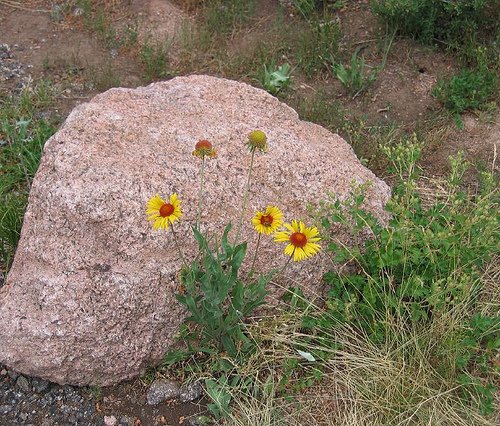
Wildflowers of Wyoming, a clump of a variety of
asters.
(*photo
credit)
June 15, 2007 Two Models of Leadership
On the feast of the Sacred Heart of Jesus we strive to be more
like Jesus who goes ahead of us and leads us in a loving manner.
The example of washing the feet of the disciples and of preaching
a leadership of loving service is different from the model of
worldly leadership of absolute power, even though the latter has
had some good examples throughout world history.
We can construct the static model of leadership with which
most of us are familiar. It is shaped like the pyramids of Egypt
with the leader at the top, and the second, third and other
subordinates further down in an ever-expanding base; foot soldiers,
who are meant to serve the rest, are at the bottom of the pyramid.
It is rigidly constructed and seen easily by others; this
leadership stands out, for all to know who is at the top and from
whom all authority flows. Many absolutist kings, companies, and
households have used this model of authority and stability for
centuries. The model testifies to the structure of hierarchy,
which does exist in some fashion in all parts of this universe. I
am no anarchist when it comes to working leadership: we do need
structure but one can doubt that a pyramid is the most perfect
model although it has been around for millennia.
Christ's washing of the feet of the disciples introduces
another model of leadership, and he turns a pyramid on its side.
There is certainly a point person but that person is like the point
or head of an arrow shooting through time, and the leader is ahead
of us and not so much above us. Jesus as leader is willing to
suffer for us and die for us, so that we may be of similar service
for our fellow human beings and all the creatures of the Earth.
This is a dynamic leadership moving outward rather than upward.
The body of Christ becomes a mobile formation thrust out on a
journey in life and determining its sub-goals while on the road.
And Christ is up ahead as the leader.
Two examples of military strategy and tactics illustrate the
two triangles although the examples are not perfect in themselves.
The vertically directed "pyramid" model was highly operative on the
Western Front during the First World War. There the British chief
commander, General Haig, a favorite of King George V, was not up
front by any means, but far behind the front and operating with a
distant headquarters staff ordering ranks of troops from the
trenches for small and quite bloody pushes; it involved a
stabilized front, a costly battle and a distant leader. A second
"arrowhead" leadership model involved the military strategy of
Alexander the Great in the battle of Issis and other major
engagements. With a small contingent and with himself in the lead
ranks, he personally attacked the nerve center of his opponents
with himself in the lead ranks. All the confederated side ranks
knew their precise role and fought according to the common goals
making minor decisions for the sake of protecting each other and
achieving the final goal of victory. More leadership should be of
this variety today.
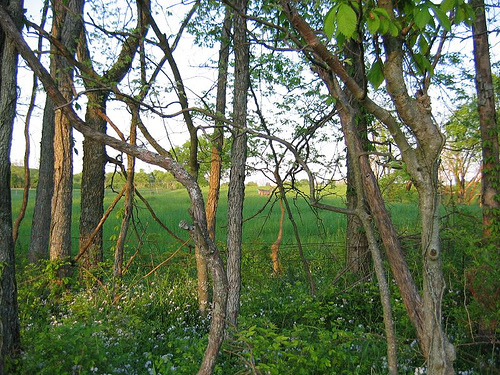
Trail's edge, Buckley Wildlife Sanctuary,
Kentucky.
(*photo
credit)
June 16, 2007 Leadership and the Principle of Subsidiarity
The notion of an outward rather than an upward thrust of
leadership is a new perspective and includes participative
leadership where possible. The direction of the movement is
somewhat self-generated because the leadership is in motion and
depends on the collective choices of all people involved. Actually
all contribute to the total momentum of the moving body.
This collaborative effort increases in time and depends on the
growth of consensus among the parts; but this approach leads to
some challenging moments among all concerned because goals may be
conceived differently among the many present. Such a model is
difficult to use well in places where leaders may look down on
others present as in a colonialist situation. A leader in our
region may consider the resident Appalachian to be inexperienced or
beneath the power of shared decision-making.
For an operation's vitality and success, all parties must
think as one and share common longer-term goals and interests.
Assuming this is the case, a group must still sort through a host
of intermediate actions and policies that will lead to these goals.
Individuals may see important matters differently from leaders, but
that is less the case when leaders are embedded in the ranks in a
service capacity. What are "important matters," according to a
broader interpretation with respect to administrative decisions and
personnel matters may depend on different perceptions of the use of
limited resources. Presuming that the organization is free to make
intermediate and minor decisions, then what is important is decided
by the ranks. Leaders must not be far distant in their salaries or
in their sense of power from the ranks.
A principle used for many decades in Catholic social action
could be helpful here. The Principle of Subsidiarity states that
nothing should be done by a larger or more complex organization,
which can be done as well or better by a smaller and simpler one.
Placed in the context of leadership: whatever can be better decided
at the broader or base level should be relegated to that level.
This principle encourages broader democratic procedure, for often
the rank and file can better understand what is occurring there
than can the people up ahead. "Leaders, don't micro-manage" is a
corollary; so is the additional one, "Respect the rank and file."
When discussing general leadership models it is hard to be
specific. A servant leadership implies concern, not a care-free or
indifferent approach of distant rank and file. Shared leadership
means that all have a concern about the proper use of time, money
and other resources, and ultimate effectiveness for participative
leadership involves good stewardship of resources. Thus as much as
possible, maximum input is always welcome, but a mechanism must be
in place to allow the consensus to be more than pro forma. We are
all moving out together, and caring for each other is the other's
business, even caring for leaders; protecting the leaders is a
matter of all parties involved because we all are called to serve.
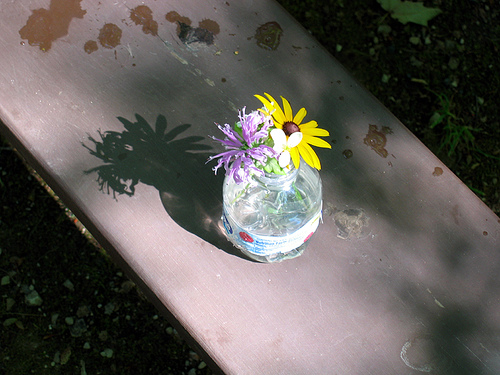
A hardy bouquet of summer flowers.
Manistique, MI.
(*photo
credit)
June 17, 2007 Expressions of Love on Father's Day
It is the man who is forgiven little who shows little love.
(Luke 7:49)
It may not appear at first reading that the story of the acts
of love by the sinful woman in St. Luke's Gospel is a story that is
most suitable for Father's Day. But let us not forget that a
father is involved in that story -- and that father is God, our
heavenly Father and the prime example of all paternity.
Mary shows so much love because her sins are forgiven, not the
inverse -- that her sins are forgiven because she has shown such
great love. God's forgiveness comes first and that gives us pause
on Father's Day, for our earthly fathers quite often follow the
pattern of God the Father, since they strive in imperfect ways to
be godly in their actions for us. Fathers are the first to forgive
us and to hope that we mature and become better. They are first in
their love for us -- but there are definitely exceptions in some
persons and in some actions of otherwise good but not perfect
people who happen to be fathers as well.
Sons and daughters strive to give acts of caring and love
whether it is the proverbial tie for Father's Day, the card, the
hugs and kisses, the kind acts of caring. It is not because of
these good deeds that we are rewarded with respect and approbation
by the fathers of the world. They do not have to be triggered --
though they sometimes are encouraged to greater acts --by such acts
of their offspring. We do these not out of our spontaneous
generosity but because of the gifts that have already been given to
us. It is a previous generosity that triggers a present response.
What is so important today is to discover gratitude that is
triggered by a goodness already shown to us and recognized by us.
Our assembling a gift or service that a father will admire is not
catalyzed by an attempt to manifest internal goodness. At all
times, in gratitude for heavenly and earthly fathers, we must exude
an atmosphere of thankfulness for things given already, not try to
manipulate the world so that we can receive more and more gifts.
We are to be sincerely grateful for the many sacrifices made for
each of us by our fathers and grandfathers (and all parents).
More attention is given to motherly love than fatherly love,
and more reciprocity is generally shown by the offspring. Quite
often a father's love is expressed differently and with less
affection and immediacy. Love for a father is often slower to
manifest. It takes time to come to appreciate a father's love, and
only a few gifted people express this well while the father is
present. What is seen only after fathers are gone, and the loving
sacrifice and concern that they showed in life become more apparent
-- and then it's too late. But is it? Maybe we return a father's
love through a sacrifice for others with confident assurance that
in the future after we are gone, our love for our father will be
manifest. And our heavenly Father knows all of this.

Alaska Highway, panoramic view.
(*photo
credit)
June 18, 2007 Pray for Peace
Christ tells his disciples that peace is his gift to them.
And it is his gift to us as well. Do we give this gift of peace a
chance? On International Picnic Day we need to do more than stage
a light-hearted tasting party of diverse cultural foods and
traditions. The real picnic is living together and enjoying life
as peaceful neighbors. Wars weary all peoples, and war strains all
of our nerves. We become bewildered and want to silence the
reports of global discord. But in our bewilderment we honestly
ask, what is the gimmick if any to bring about peace?
Americans voted in 2006 that they were war weary; they are
now demanding timetables and bench marks to get out of the
quicksand of Iraq. Depending on how we calculate when the
Revolutionary War and Vietnam War started and ended, we Americans
are now in a longer war than most we have experienced, and
certainly longer than all the remaining ones: the War of 1812,
Mexican American War, Civil War, Spanish-American War, World War I,
World War II, Korean War, and the First Gulf War (all four or
fewer years). We yearn that this seemingly interminable conflict
may end and do so happily for all parties. But war is not a
pathway to peace nor a final settlement of conflicting issues.
That lesson is so hard to learn. Many of us said in March, 2003,
that this emerging conflict could cost the horrible sum of fifty
billion dollars -- and sadly enough it has already cost ten times
that extraordinary sum and counting. The minority of us who did
not want to go to war mentioned then that peace is far more
difficult to establish than an armed conflict is to initiate.
If war is not the answer to peace and the way is totally
unclear, is there still something we can do while striving to bring
the troops home sooner rather than later? Yes, we first must be
honest. The conflict is not about our permanent conquest of oil-
rich Iraq. And next we can honestly pray that this message is
heard. We can pray for peace and do so with a fullness of faith.
If a deep enough faith can move mountains, so should it move the
barriers that separate us from peace. The truth just might be that
we do not believe in the power of prayer in a deep enough manner,
or we are dishonest in what we state we are praying for. We can
hardly expect dishonest prayers to be answered. But true peace
must come from sincere hearts, and so we pray to fathom our
sincerity in its deepest core.
We want to believe that all want peace, and that obtaining
peace is a matter of praying all at the same time as hard as we
can. But some do not want peace: terrorists, spoilers, those
regarding themselves as needing time to get revenge, manufacturers
of war materials, certain ones who like war at least on others,
those who hog or despoil the world's resources, etc.
Unfortunately, the "etc." may be a large number of us. However
great the number, we must persist in our prayer even when the
counter-effects seem so very overwhelming. Love is more powerful
than hatred. Do we truly believe it?
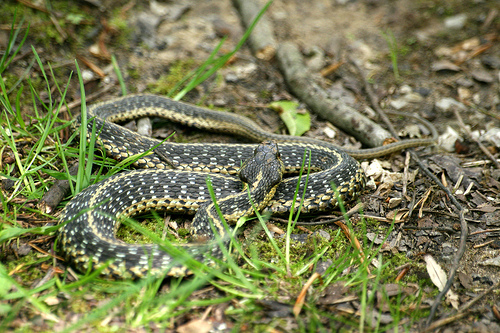
Common Garter Snake, Thamnophis sirtalis.
(*photo
credit)
June 19, 2007 Tar Sands
As controversy over global warming and climate change heats up
this summer, proponents of various energy alternatives will give
their pitches like barkers at a fair. We should take the concept
of energy variety with a certain guarded reserve, because some
sources may not solve the growing global problem and others may
help. Our basic contention on this website has been quite
ecologically consistent, practical, community friendly, and low-
priced: the impact of climate change can be reduced through the
practice of proven energy conservation measures coupled with the
use of renewable energy sources principally wind and solar energy.
The renewable sources can certainly be expanded in given
circumstances to include geothermal, wave and tidal energy,
biological waste utilization and some others. We believe that the
line must be drawn however, for not every fuel source will improve
the current energy situation, especially not nuclear energy and
shale oil reserves (1/10/06). Let us with some reluctance add
still another questionable source that is easier to secure and is
being tapped at this time, namely, tar sands. Portions of Alberta
Province in western Canada contain a major portion of the world's
discovered and exploitable tar sands, which hold an estimated 175
billion barrels of crude oil -- making Canada second only to Saudi
Arabia in known and proven oil reserves. This nearby source is
certainly enticing, especially since proximity is combined with the
stability of the Canadian government.
Having said all this, we must note that the oil from tar sands
does not come by just pumping. This "black gold" is locked in the
sands at various depths although not so tightly locked as shale
oil. However, many of the listed disadvantages of exploiting that
vast shale source also apply here: the energy process produces
carbon dioxide that will still increase the global warming
phenomenon; the process of extraction is energy intensive and thus
more carbon dioxide is released to yield the oil; tree cover will
have to be removed to get to the source using current extractive
means; water in relatively large quantities will be required in the
extractive and purification process; and the finished product will
be costly, though with the rise in oil prices it may prove
competitive.
A moderation in the tar sands argument is that methods are
being developed to heat tar sands while in place by pumping down
heated water or steam (all at energy costs) and extracting the
liquefied materials through pumps leaving the sand behind.
Environmentalists are pointing out that such in-situ processes
could result in aquifer contamination, thus rendering scarce ground
water less useful. Existing reclamation efforts have been
elementary, while surface mining operations could be extensive and
the revegetation may not prove highly successful. Tar sands offer
a slightly better promise than shale oil (which may not be a net
energy gain at all). However, why tap tar or shale when the same
investment of money could develop clean wind and solar resources?

Fort McPherson, Nebraska, old mobile
home reused as office for tent
campground, decorated with neatly potted flowers.
(*photo
credit)
June 20, 2007 Pack Rats
Note immediately! This reflection is about the favorite
wildlife of the month, the Allegheny woodrat, Neotoma magister, not
about compulsive human hoarders who bear the same designation. I
have experience with both varieties (wildlife and human) but the
former encourages a far better reflection. Wood or bushy tailed
rats come in different sub-species in various parts of the
continent. However they are all native wildlife gifted with high
intelligence. In some places where construction has occurred,
these woodrats are actually an endangered species. We need to
remember that their ancestors were settled here long before the
advent of the Europeans and their larger and more despised and
prolific "Norwegian" or common rat cousins who favor urban life to
the rural habitat of the pack rat.
The term "pack" has to do with what they pack in when they
build their nests, not with living,, traveling or working in groups
or packs. In fact they are rather solitary and nocturnal
creatures. They are sometimes known as trade rats because they are
attracted to shiny objects and will substitute a piece of jewelry
for a pebble that they are carrying (dropping what they are packing
for something that their fancy takes to). Items discarded show
that woodrats do not our economic values, and so one can only guess
what is gained or lost when the pack rat visits.
We happened to build the ASPI Nature Center at Livingston,
Kentucky in an area where pack rats lived. They soon wanted us to
know this. We had a debate over whether we would kill them and
decided to do so only if the problem became serious. I was
astounded that one of these nocturnal creatures could slip in and
peck at (strike with their teeth) a metal jar lid in one direction
and thus unscrew it to get to food. I showed the phenomenon to
Professor Emeritus Wayne Davis of the University of Kentucky
Biology Department and he was utterly surprised. Our patience grew
thinner with further visits, and so we started to show the woodrats
our displeasure. A type of sticky paper arranged so that the
centered bait could only be reached by traversing the paper was
first used. However to our surprise the pack rat could remove the
bait and never get its feet wet. That called for more drastic
measures -- over objections from our naturalists. Before it was
all over we had some good laughs, with a typed note left "by the
rat" ridiculing our manager's attempts.
The truth is that woodrats do not have the propensity to
multiply like their non-native cousins. Where possible they ought
to be tolerated, for they are part of the wildlife landscape.
Today, woodrats are preyed upon by the rapidly increasing coyote
population in this part of the country (see May 20, 2006). They
may soon become threatened or even endangered and so some effort
must be made to actually protect them. I must say that after all
our battles with them, they did gain our respect -- and I never
ever thought I would have a warm feeling about a rat -- but I have
about the non-human pack rat. Now human ones are another story.

Totem near Prince Rupert, Canada.
(*photo
credit)
June 21, 2007 First Nations Day
The Summer Solstice, which is highly regarded by many of the
Native American groups, is a perfect time to reexamine our
relations with those first nations that were present long before
the advent of Europeans to the Americas. Thus there was a complex
of nations situated before a United States, Mexico and Canada.
Unfortunately, many of the records of these nations have not
survived the destruction by armies, disease and the forced
migrations of peoples. Written records are patchy at best. I
remember one unrecognized tribe in Maryland asking a group of us to
see what we could do to get from the Vatican Library the only
written record of their own language. And with many of the Native
American languages threatened, this was a most timely request.
More permanent records are sometimes kept in totem poles, in
wampum belts, in carvings and architectural structures, in mounds
(for more primitive peoples), in pottery, in buried grave
artifacts, in the remnants of trails, and in etchings and signs in
stone. The lack of permanence through the use of wood, hides and
various fibers is a fact. Records were more often passed through
living traditions in stories passed down from one generation to the
next. What material records we do possess show an amazing cultural
sophistication that makes its own fascinating study. Our only hope
is that much of the living tradition can survive at this time of
overpowering American monolithic cultural practices.
So often, Native American youth forget their cultural
practices and keep only bare essentials. Languages are being lost
at an astounding rate. One can speak of the last Delaware native
speaker and unfortunately the story is the same for other scattered
tribes. More culture will be threatened unless all Americans
consider the first nations to be a living part of our collective
cultural treasure: place names; food (cooking and preservation);
crop-growing techniques; edible and medicinal plants; respect for
mountains and forests; water conservation techniques; and manner of
working and treating each other in communities. Much has been
assimilated and more is to be gained by observation and
understanding.
Unfortunately, one of the only bright spots in the long sad
history of Native American recognition is the lucrative practice of
gambling on tribal lands -- and this gives rise to some severe
problems. On many reservations surplus money is funneled to
needed educational and health services. But the volume of these
emerging funds can put stress on a particular community spirit.
Income must come from a more solid basis than gambling, for the
existence of cultures is at stake. Even with thriving casinos
there is no guarantee that the Native American nations will be
independent of the all-embracing European-derived governments. The
Native American diversity in culture and expression is a good
thing and should be preserved and enhanced with time in this
twenty-first century. If Earthhealing involves protecting species,
from extinction, it should include preserving cultures as well.
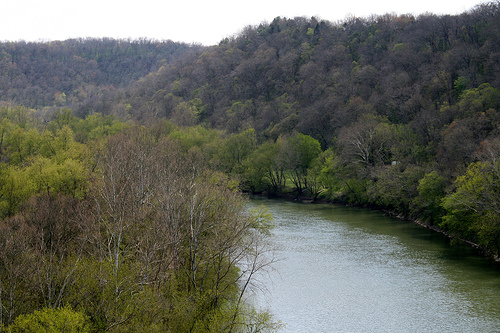
The Kentucky River, Anderson Co, KY.
(*photo
credit)
June 22, 2007 The Kentucky River
Our 259-mile Kentucky River was charming to the first pioneers
who saw it in the 1750s, and still is today. While development and
pollution have made a dent in the river's appearance (especially
home development above the Palisades), still its setting in the
Mountains, the Bluegrass and the Knobs has remained much the same
for millennia. The river serves as a major migration route of
wildlife. About 40% of the course of this river has scenic
limestone cliff palisades that support some of the only native
vegetative setting in the Inner Bluegrass Region (big bluestem,
wild oats, riverbank goldenrod, shrubby Saint-Johns wort, and
tufted hair grass).
The Kentucky River arises in the state's eastern highlands;
its watershed of about 7,000 square miles does not extend into
other states although its waters empty into the Ohio River and the
Mississippi system. Adding to the Kentucky River's charm are the
many contributory streams, creeks and smaller rivers such as the
Red, flowing from the scenic Red River Gorge, and the Dix River,
spanned by High Bridge. In the nineteenth century, before the
Kentucky River was tamed by the construction of fourteen locks and
dams to create pooled areas for navigation, the river would flood
and carry logs to sawmills further down stream. This logging
transport period was a wild time that is well narrated by Judge
Ralph E. McClanahan, Sr. in "Kentucky's Miniature Nile"
(Beattyville, KY: Powell Press, 2001). The Judge also permitted
two of us to make a half-hour videotape of his reminiscences of the
Kentucky River (available in the University of Kentucky Library
special collections). The Judge lived most of his long life along
the river and served on the Kentucky River Authority board.
Today, I am privileged to live within sight of this famous
river, which begins at and near Beattyville where the south, middle
and north forks that drain portions of eastern Kentucky join and
become the mighty Kentucky. From there to the Ohio River this
waterway meanders, adding to the mileage before it ends at
Carrollton, Kentucky, on the Ohio River. The stream has relatively
little commercial traffic and is used more by pleasure boats
(houseboats, motor boats, yachts and others) than by freight
barges. The Kentucky River is a source of domestic water for about
one-sixth of the Commonwealth's population; and thus the need for
a high water quality. The basin is blessed by not having heavy
upstream agricultural and industrial runoff.
The most valuable potential economic assets of the river are
recreation and tourism. Sight-seeing is the major tourist
"activity," if we call using our eyes an activity, and the Kentucky
is an eye-full from start to finish. Water sports are becoming
increasingly popular, and fishing has always been important due to
an abundance of river life. Row boats compete in places with high
powered motorboats, though not to the same extent as on the Ohio
River and the lakes further south. Let's hope the Kentucky River
retains its charm for future generations.
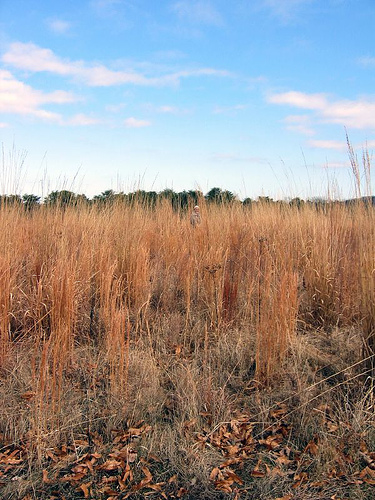
Prairie tall grasses, Bernheim Arboretum
and Forest,
Kentucky.
(*photo
credit)
June 23, 2007 Prairie Tall Grasses
The accompanying picture shows some prairie tall grass at a
nature center in central Kentucky. Our Commonwealth stands at the
edge of the Great Plains and, though it had areas of prairie grass
before the coming of the white man's plow, still the grasslands
here are not as expansive as across the Ohio River in the "Prairie
State" of Illinois. However, here as elsewhere much of that
prairie tall grasses has been plowed under and the land converted
over to other uses. In fact, Illinois has only one hundredth of
one percent of its land in prairie at this moment, and other
Midwestern states have infinitesimally small amounts as well.
There remain only small remnants of what was a ribbon of green
across the entire mid-section of North America (about one third of
our land and a major portion of central Canada as well).
My own particular connection with these grasses other than
admiring their resilient nature is that the name "prairie" was
apparently applied to grasslands by Jesuit missionaries in the 17th
century in what is now our Midwestern states. The early explorer,
Pere Marquette, coined the "les belles preries" or beautiful
grasslands following his French tradition. All the early visitors
and settlers recognized the beauty and dreamed of fertile flatlands
becoming agricultural pastures and cultivated fields.
The major good news is that most of the dominant tall grass
species (big bluestem, little bluestem, needlegrass, Indian grass
and about 150 other varieties) have not become extinct, and with
judicious care could be resown into new native grasslands. And
with an expanding interest in ecological ways, one can expect that
more and more of the Great Plains will return to prairie
grasslands. Each year several new tracts are returned and I am
happy to see the Clinton Franciscans return some of their land to
prairie wildscape.
What is equally good news is that these lands could support
moderate to large herds of buffalo. These natives of the Great
Plains are a potential nutritious protein source in a protein-short
world of hungry people. I have never been certain whether the
dream of a friend, Wes Jackson of Kansas, to harvest the seeds of
some of these grasses as a protein source can actually succeed --
but the production of meat through grazing the grasses is well
recognized.
An added benefit that would accrue from the return of the
prairie grasses is that their root system is so extensive that some
of the carbon from the carbon dioxide that is increasingly given
off through fossil fuels combustion could be stored naturally.
Some even believe the storage could be greater than the Amazon
forests that we hear so much about. The prairie grasses are
native; they are able to flourish under the hoofs of the buffalo;
they can endure droughts and do not need pesticides or commercial
fertilizers in order to flourish. The time is right. Let us
return the Great Plains to tall prairie grass and do so now.

Rural overlook onto small community, Franklin, TN.
(*photo
credit)
June 24, 2007 John, Herald to the Nations
I will make you the light of the nations so that my salvation
may reach to the ends of the Earth. (Isaiah 49: 6)
John the Baptist is an important figure in the mission of the
Messiah for he is appointed by God to herald the Good News, Jesus
Christ himself. Thus John's feast takes grater precedence than the
normal Twelfth Sunday of Ordinary Time (the regular Pentecost
Sundays). Why such importance? In part, it is because of the
model John is to be for all of us in our mission in life; he
responds whole-heartedly to his calling. Also in part, his
greatness is based on his vocation to be a key prophetic figure in
the ushering in of the New Covenant; John is called to be at the
right time and place -- and he responds wholeheartedly.
Jesus pronounces John's greatness when asked by others, for
John addresses the people, preaches repentance and preparation for
the coming of Christ, and baptizes hearers through a sign of what
is to come. John does these things through word and example -- a
clear denunciation of evil and a simplicity of lifestyle. In
performing this prophetic role John is arrested and eventually put
to death. The elements of a true Christian witness are all
present, and yet John does not experience the saving message of
Jesus as do the Lord's disciples. So much for the paradox of
John's mission and earthly life, but some saints become great by
being popularized in death, and thus it is with John the Baptist.
Our call to sanctity comes with some of the difficulty that is
found in imitating John the Baptist. Are there elements worth
imitating from his life? We too are called to live a simple life
and make do on what we have in this age. We must denounce crass
materialism. We are called to perform our duties humbly and to see
that those whom we serve are far greater than we are -- and yet we
must serve them whole-heartedly as well. We are called to tell the
truth in this time of wanton wealth and power even when others will
deeply dislike us for saying such things. We may not be required
to lose our heads over such discussions, but we run risks all the
same.
We are to be a light to the nations. Each of us must have
faith in the power of our works, not because they come from our
supposed self-generated power, but because all power in the risen
Lord comes through the Holy Spirit, the Spirit of truth and life.
This website has visitors from ninety-five countries so we hope it
can become a light to the nations. Hopefully, this too is
spreading the Word of God to all creation (Mark 16:16). We have
had no power to introduce or retain the functioning of the
Internet, and yet we are here to be a heralding voice in the
wilderness, announcing that part of the Lord's message is to heal
the Earth. This instrument is even more valuable than was the
Roman road network was for spreading the Good News in the first
century of this era. We must imitate John the Baptist and heed our
calling, seize the moment, and help attain God's greater glory.

Photographer's companion, sharp eyes and
ears in the forest.
(*photo
credit)
June 25, 2007 Creature Companions
A story about a young girl in Ethiopia who was abducted and
taken into the woods and left while ransom was being sought
recently appeared in the media. Obviously the little girl was
distraught and crying, and some lions came close and somewhat
consoled and protected her until the search party came and rescued
her. What appears to have occurred is that the lions showed a
sense of compassion, a feature that can often be found within the
natural world when we search for such instances in the loving
manner of St. Francis and many of those in tune with nature
throughout human history. This story opens us to our discovery of
the move to companionship within all of creation. We spoke about
animals being our companions (August 8, 2005), but we ought to
extend this sense of companionship to all of creation. We are all
interrelated, and interrelationship ultimately involves a sense of
kinship and companionship. We can opt to see the world as a cold
place where dog-eats-dog, or we can find ourselves amidst some
friendly huskies on a cold winter night. Our way of approaching
the rest of creation defines our isolation, or our embrace of an
ever widening arena of love. The challenge is to be companions.
While we can experience this companionship of all creatures
better among more sensate animals, still this phenomenon reaches
beyond. When we take a hike in the quiet woods, there is the
companionship of the plant world with us -- the amount of greenery
on the trees, the whisper of leaves swaying in the breeze, the
color and beauty of the short-lived wild flowers -- all lifting our
hearts to new heights. The plant world speaks if we but listen.
This is especially true when we go out on a warm June evening and
admire the growth of vegetables and herbs in our gardens. These
plants seem to look up and smile. When we water them in dry times,
they seem to express gratitude for this vital supplement.
A more difficult sense of companionship is among the rocks and
rivers, the sky and heavenly bodies. But relationship is there.
The first hermit, St. Anthony, lived to be over one hundred in the
Egyptian desert and was illiterate; it is recorded that he was
able to see God's revelation expressed in the rocks of the desert
where he resided. The mountains and the deserts speak but the
language is only heard by those well attuned to a broad-based
companionship of all creatures.
Some record the travails of being lost or marooned in some
distant and harsh location. Perhaps their feelings are correctly
narrated since being lost is a distressing experience. We all
become panicked one or other time. But most of the time we know
our way and have a grand opportunity to take advantage of a
tranquil location and a chance to "commune" with nature. Some
dismiss such circumstances as poetic extravagance. But this
belittles our journey of faith. Far better for us to take the
precious moments of finding God in the natural world and thank God
along with other creatures for such a discovery.
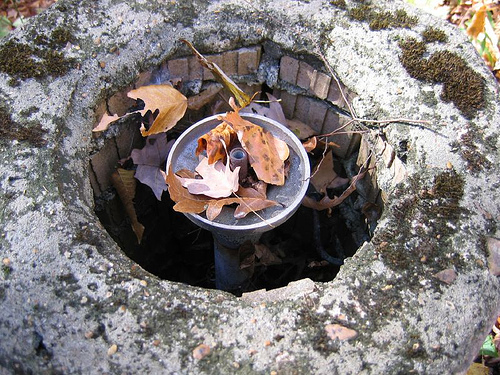
Broken fountain / Natchez Trace, Tennessee.
(*photo
credit)
June 26, 2007 Stations of the Eco-Cross
1. Jesus is sentenced to die. Species on the Earth are
endangered or threatened with extinction due to general
environmental pollution.
2. Jesus takes up his cross. People must bear the suffering of
their water pollution with no potable domestic water.
3. Jesus falls the first time. The understory is trampled
upon, and soils are allowed to erode for lack of cover through
various forms of land pollution.
4. Jesus meets his mother. Chemical Pollution results in birth
defects and crippling illnesses, which confront poor families.
5. Simon of Cyrene helps with the cross. People make empty
gestures by washing oil-soaked seals or sea gulls in the polluted
seaways.
6. Veronica wipes the face of Jesus. Reclamation efforts do
not erase all the scars of the land, and landfills do not halt the
solid waste pollution resulting from an excessive consumer culture.
7. Jesus falls the second time. The forests and all life
suffer from air pollution, which weakens the immunity of the
biosystems and cause many to fall ill to disease. Coal-fired
powerplants belch plumes from their smokestacks.
8. Women weep for Jesus. The anguish of people especially
women over the wounded Earth is often drowned out by the honking,
screaming, blaring, and explosions occurring through the discordant
sounds of noise pollution.
9. Jesus falls the third time. The trees are cut away by
greedy folks in the tragedy of clear-cutting.
10. Jesus is stripped of his garments. The Earth is strip-mined
and denuded when coal and other resources are taken for profits.
11. Jesus is nailed to the cross. The Earth is impaled with
rows of gaudy signs and other forms of rampant visual pollution.
12. Jesus dies upon the cross. People die of hunger, the AIDS
epidemic and many other afflictions because the resources were not
expended properly. "Look what they have done to my Earth."
13. Jesus is taken down from the cross. The added suffering is
the slums and the pungent odor pollution of the ruined countryside.
It is present for all to endure even in dying communities.
14. Jesus is placed in a sepulcher. This tired Earth is laid
low but it has hidden life, a resilience that will allow it to rise
again and to become a promised New Heaven and a New Earth.
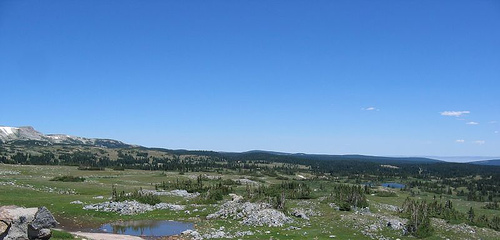
Hiking with blue sky, an alpine scene in central
WY.
(*photo
credit)
June 27, 2007 Cash Replaces Food Parcels
The Guardian Weekly for March 2 to 8, 2007 (p. 30) has a story
by Chris McGreal telling how the United Kingdom is backing an
experiment in the way aid is delivered within foreign countries.
The article reports that the UK Department for International
Development is making a one and a half million dollar grant
available in small dispersements to people in northern Malawi.
This is done through an electronic identification scheme to prevent
fraud and is focused on making cash available to the hungry instead
of food. This follows similar schemes that were used a few years
back in Asian tsumani and Pakistani earthquake relief. The routing
is done directly through the governments of the participating
countries and is thought to be more accountable because the
recipient benefits can be determined with greater ease.
The advantage of this cash instead of food procedure is that
it is a far less rigid approach. Choices of use are left to
hungry people, not to donors in the form of specified aid packages.
In many countries local agricultural producers are undercut by
foreign food surpluses. However, this experiment is not without
its critics. The United Nations World Food Programme argues that
cash can be diverted more easily (presumably to non-food items)
than can sacks of corn or other foodstuffs. In developing as well
as developed countries corruption comes in many forms. However
some aid groups support the experiment. Oxfam found in a cash
program in Zambia that the most affected people received the
assistance at nearly half the cost of delivering food directly.
We need the best when it comes to feeding hungry people. We
have the principle that we ought to eat locally grown food.
Shipping food as well as other bulk necessities over great
distances is not an ecological way of proceeding. If rising food
prices affect the poor in a higher degree and if they are able to
purchase some available food, we should support local producers.
Obviously, in regions where there are genuine food shortages
through drought, shipment from distances is the only humanitarian
approach that will tide the people over to another growing season.
Many argue that Africa can feed itself in the long term.
Theoretically that may be true, but people do go hungry in 2007.
We must keep our eyes on the hungry and the local economy.
Shipment of money instead of food could be one answer. Though
the schemes for distribution differ in various African countries,
it does seem as though an electronic transfer system like the "food
stamp program" now in effect in the United States reduces fraud and
corruption and could be handled successfully in other countries as
well. The stark fact remains that a large number of these sub-
Saharan Africans go to bed each night hungry, and thousands of
infants die each day from malnutrition. If Africa produces
sufficient food to meet its needs, then the money system of aid
would rebuild the local agricultural economy and turn producers
away from corporate, export agricultural commodity schemes and back
to supplying the basic needs for native people. And all rejoice!

A great blue heron rests by a Kentucky lake.
(*photo
credit)
June 28, 2007 Heron Dance
For several years we have featured a particular group that is
seeking to save our wounded Earth in some fashion. For this month
of June we feature a publication, Heron Dance: A Work of Love.
This semiannual periodical is the inspiration of Roderick MacLver
who is listed as artist, founder, and editor. Readers as well as
producers of this journal are quite dedicated because the painted
pictures and the stories contained have a haunting sense to them
not found elsewhere; they draw us to deeper reflection.
Heron Dance does not contain photographs as such, but rather
an "organic" or a totally non-commercial approach to presenting
material to the public (I am unsure what the staff's feelings are
at this time about digital photos or the use of Internet instead of
paper for I met Rod only once a number of years ago, and times are
changing for everyone).
Heron Dance presents itself as "An effort to produce something
that is thought provoking and unique, that has a sense of peace
about it and that is aesthetically beautiful. Heron Dance is a
celebration of the gift of life -- a refuge from our commercial
fast-paced world. Through watercolors, interviews, quotations,
book excerpts, essays and poetry Heron Dance celebrates the
seeker's journey and the spirit and beauty of all that is wild."
Certainly the produced watercolors are extremely beautiful and
eye-catching as all readers will readily testify.
The editors tell us that they publish this journal twice a
year for a subscription price of $30. The publication invites the
reader to view its website that is certainly worthy of a visit
<www.herondance.org>
The press and studio are at --
450 Shunpike Road
Williston, VT 05495
Note: At the Kentucky State University Aquiculture Center in
Frankfort, director Steve Mimms tells us that the local blue herons
have adapted to the straight siding of the fish tanks, which do not
allow them to wade out in the traditional way to do their fishing.
Instead, the herons have become nature's PT boats and speed in
under the netting that protects the fish and get their catch in a
different way using their bellies and feet as paddles (duck like).
Evolution now! And dancing is no longer involved. We all are in
the process of change for that is natural.
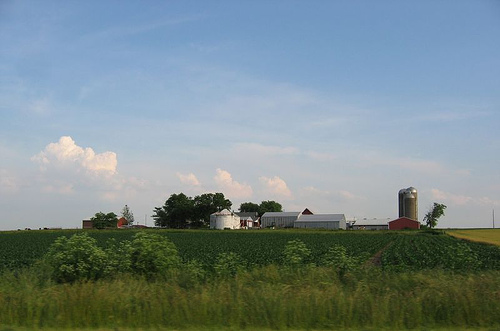
Farm scene under beautiful partly cloudy sky,
western Iowa.
(*photo
credit)
June 29, 2007 Should We Ask Questions?
Why do some people stop asking questions? Is it because they
have been taunted so often that they start to imagine that they are
stupid or simply out of touch with the non-asking majority? Is it
because they leave questioning to precocious little kids? Is it
because adults are to know it all, or think something is not worth
knowing, or that matters have been described by someone else in
some hidden research report? Is it because not asking is supposed
to be the sign that I already know it all and don't need to know
any more for the duration of life? Is it because the other party
simply does not want to hear me asking because in all fairness they
have so many unanswered questions that there is no more mental or
psychic space for one more infernal question?
Didn't the Virginia Tech episode a few months back raise more
profound questions than whether the perpetrator was mentally
unbalanced? Did it tell us that the American dream comes with
wrinkles, and that some find it impossible to play the competitive
game in which college preparation has a preparatory role? Does the
affair fascinate us more than the larger number of Iraqi who were
killed that very day in at least as trying a set of circumstances
as happened in Blacksburg? Does it announce through the sound of
gun reports that at least the ammo should never have been sold to
civilians whether of sound or unsound mind?
Are we not in a tradition on the feast of Peter and Paul of
joining these great forebears of faith in wondering who it was whom
they followed so closely? And where was Jesus going after he
departed this life? And how was he calling them to be disciples?
What did it take to follow in the footsteps of the master? In what
way was discipleship a giving up of self to serve another even in
a different cultural environment? And where do we fit in on our
individual and communal quest of faith?
Why am I here? Wasn't that the question of a third party vice
presidential candidate in 1992, a comment that drew a multitude of
laughs when relayed by late night comics? And yet was not this a
rather profound question, the beginning of a theological
investigation of our very existence in this time and place? And
wasn't this the question my centenarian first teacher asked me at
the end of her long life? Why was she left when her friends had
all departed? Wasn't this the question on Senior Citizens' Day?
And how do we answer?
Are we starting to conclude that not every question has been
asked much less answered? But should such unknown vistas restrain
us from asking and continuing to ask questions that seem to deepen
in profundity as we age? Why not ask and ask again and again? Is
not our constant questioning due to our quest for God? Does this
show our journeys' incompleteness? Will I still have the energy,
freshness, ability and hope to ask over and over, until the answers
begin to appear as the first streaks of dawn? You can't answer
these questions any better than I, can you?
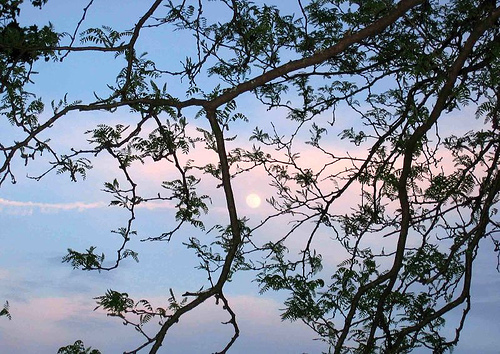
A rising Kentucky moon in June.
(*photo
credit)
June 30, 2007 Only Once in a Blue Moon
That orbed maiden with white fire laden, whom mortals call the
Moon... Percy Bysshe Shelley's "The Cloud"
June 30th is the second full moon (or a "blue moon") of the
month, a phenomenon that occurs about forty-one times in a century.
We had the first full moon on June first, "Strawberry Moon" and
"Rose Moon" now at June's end. There is something about a full
moon that brings out the best and worst in each of us: a sense of
romance and hope; an alleged streak of lunacy from "Luna" the Latin
word for moon. Some people feel nervous and uneasy at full moon.
By golly there's the moon! I doubt if I ever voiced this
before in my life. This soft and luminous body does not often gain
my or our attention and we all too often take it for granted -- but
should we? The only other moon-related treatment in this body of
reflections concerned the effects of light pollution that so often
dims our vision of the heavens. I remember the first time that I
noticed the moon during the daytime and wondered why this nightly
body was kicking around in bright daylight. Was it lonely for
attention? Now in more mature years I ask myself just how much
time I spend gazing at the moon whether in its full or partial
phases. Most likely only a small fraction of an hour of a
lifetime. We may give it only a passing glance although gazing
does not have the harmful effects of staring at the blazing sun.
When I was growing up, some farmers in our countryside gave
extraordinary credence to moon signs, especially for planting
crops. For them, seeds seem to germinate better in the particular
phase of the moon. My Dad spoke of putting down a plank in grass
at certain phases, and the grass beneath would die at certain times
of placement and not at others. No doubt the affecting of tides by
the moon has been long known in our world; the moon does have an
effect upon Earth and perhaps on vegetation.
"Blue Moon of Kentucky" is a grand song by Bluegrass musician
Bill Monroe. This is a descendent of the "Beautiful Moon over
Kentucky," unknown authorship. The hope of all who treat the moon
through verse and song is that the moon will keep on shining -- but
that is more than poetic license. The moon could be dimmed either
by increasing air pollution that could make it impossible to see
beyond the low-lying fog, or by light pollution (July 20, 2006).
Yes, blue moons are rare but they come also with some regularity,
and so rarity occurs and is expected. The last blue moon was July
31, 2004. The appearance of a blue moon is not haphazard and
unpredictable; rather it is truly a part of the natural cycles and
can be predicted for years to come. The lesson we learn is that
what is rare is part of reality, and we remember that rare comets
and shooting stars were accompanied by anxiety and omens of
foreboding events. Let's turn our gaze calmly to the heavens
tonight and admire the marvels that the creator has wrought -- and
say a prayer that the sky will not be too cloudy and that we can
always see the heavens clearly.
|